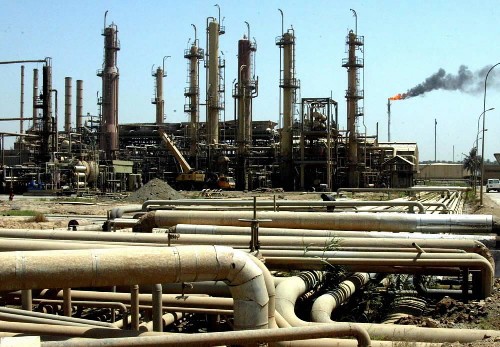Oil Output of OPEC in August Increasing
Posted: 08/29/2014 05:08:43 Edited: 08/29/2014 05:08:11 Clicks: 867
On Thursday August 28, a survey of Reuters showed that the average oil output of OPEC in August is 30.15 million barrels per day, higher than 30.06 million barrels per day in July. Increasing oil supply in Libya, Angola and Iran highly exceeded the further decline of output in Iraq. The survey of Reuters is based on shipping data and the information from oil companies, OPEC and advertises.
The oil output in Saudi Arab was basically flat those in other core oil producing countries in Gulf to a large extent. Saudi Arab did not decrease oil output to support oil price. Or Libya increasing output may put on reserve. Oil price in August had ever decreased to about 101 dollars per barrel, which was the lowest level in 14 months.
It is the second continuous month that oil output of OPEC is higher than 30 million barrels in the name of the goal because of increasing oil output in Libya, Angola and Iran. In the several months before July, unwilling interruption of oil supply such as in Libya resulted in OPEC failing to reach the goal.
OPEC consists of 12 countries and its oil output accounts for one third of global output. In August, oil supply in Libya was increased by 1 hundred thousand barrels per day, making the largest contribution to output of OPEC. However, analysts considered that the recovery of oil industry in Libya may be just transient due to continuous conflicts.
Garsten Fritsch, a commodity analyst of Commerzbank which is located in Frankfurt, Germany said, “I think that oil industry recovery in Libya will continue. But it may encounter frustrations and recovery will be quite slow. That is not a one-way traffic.”
It is the second continuous month that oil output of OPEC is higher than 30 million barrels in the name of the goal because of increasing oil output in Libya, Angola and Iran. In the several months before July, unwilling interruption of oil supply such as in Libya resulted in OPEC failing to reach the goal.
Angola was next to Libya. In August, CLOV program of Total in Angola had already export oil by using four oilers, higher than zero output in July.
Insiders stated that the output in Saudi Arab, Kuwait and United Arab Emirates were almost the same. In Saudi Arab, increasing oil consumption in power stations resulted in decline of export volume.
Iraq had the highest output reduction. The export of oil terminal in the southern of Iraq was delayed of for climate, leading to Iraqi output being decreased by 1.4 hundred thousand per day.
OPEC will hold a meeting to discuss the policies of oil output in November. The representatives of OPEC and the ministers from member countries disclosed that OPEC was not fear about oil price having decreased to the lowest for several months. Zanganeh, the Minister of Iran Oil Department had ever stated clearly, “Decline of oil price is caused by seasonal fluctuations and it will not carry on falling.”
The oil output in Saudi Arab was basically flat those in other core oil producing countries in Gulf to a large extent. Saudi Arab did not decrease oil output to support oil price. Or Libya increasing output may put on reserve. Oil price in August had ever decreased to about 101 dollars per barrel, which was the lowest level in 14 months.
It is the second continuous month that oil output of OPEC is higher than 30 million barrels in the name of the goal because of increasing oil output in Libya, Angola and Iran. In the several months before July, unwilling interruption of oil supply such as in Libya resulted in OPEC failing to reach the goal.
OPEC consists of 12 countries and its oil output accounts for one third of global output. In August, oil supply in Libya was increased by 1 hundred thousand barrels per day, making the largest contribution to output of OPEC. However, analysts considered that the recovery of oil industry in Libya may be just transient due to continuous conflicts.
Garsten Fritsch, a commodity analyst of Commerzbank which is located in Frankfurt, Germany said, “I think that oil industry recovery in Libya will continue. But it may encounter frustrations and recovery will be quite slow. That is not a one-way traffic.”
It is the second continuous month that oil output of OPEC is higher than 30 million barrels in the name of the goal because of increasing oil output in Libya, Angola and Iran. In the several months before July, unwilling interruption of oil supply such as in Libya resulted in OPEC failing to reach the goal.
Angola was next to Libya. In August, CLOV program of Total in Angola had already export oil by using four oilers, higher than zero output in July.
Insiders stated that the output in Saudi Arab, Kuwait and United Arab Emirates were almost the same. In Saudi Arab, increasing oil consumption in power stations resulted in decline of export volume.
Iraq had the highest output reduction. The export of oil terminal in the southern of Iraq was delayed of for climate, leading to Iraqi output being decreased by 1.4 hundred thousand per day.
OPEC will hold a meeting to discuss the policies of oil output in November. The representatives of OPEC and the ministers from member countries disclosed that OPEC was not fear about oil price having decreased to the lowest for several months. Zanganeh, the Minister of Iran Oil Department had ever stated clearly, “Decline of oil price is caused by seasonal fluctuations and it will not carry on falling.”

